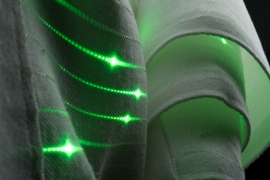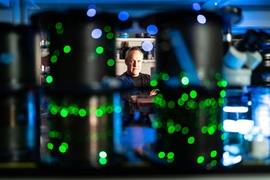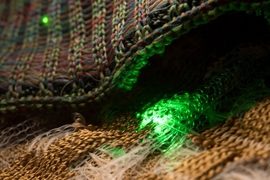In an opinion piece published in the journal Matter, members of the Fibers@MIT research group recently laid out a detailed vision for how the rapidly growing field of advanced fibers and fabrics could transform many aspects of our lives. For example, “smart clothing” might continuously monitor temperature, heart rate, and other vital signs, then analyze the data and give warnings of potential health conditions. Headed by Professor Yoel Fink, the group is developing fibers and fabrics with advanced computational properties. MIT News asked PhD student Gabriel Loke, who was the article’s lead author, along with Fink and six others, to elaborate on the team’s outlook.
Q: The paper you just published describes a vision for a fabric computer. Could such computers help to address a pandemic situation like the one we confront now?
A: The current pandemic has revealed the need for new paradigms to assess the health of large populations in real-time. Current approaches of symptom-driven tests are lagging indicators, and can be likened to driving just with your rear-view mirror, as far as the spread of Covid-19 is concerned. So how do we create systems that are predictive, forward-looking and can deliver leading indicators? What if you had a way to access your vital signs on a continuous basis? Could subtle, imperceptibly small changes become early warning signs for the health issues of an individual? What if you could correlate in space and time these changes for a large population, and do so in real time, to identify the spread of disease?
No human-made objects are more ubiquitous or exposed to more vital data than the clothes we all wear. Wouldn’t it be great if we could somhow teach our fabrics to sense, store, analyze, extract, and communicate this potentially useful information?
In this piece, I describe the four principles for this new computer. First, the capabilities of a single strand of fiber will advance rapidly over time through new material designs and scalable fiber fabrication approaches. The second step is the synergistic assembly of these fibers into a fabric uniquely positioned to capture, store, and process vast amounts of data released by our bodies. The third is the development of artificially intelligent fabrics, where specially architected machine-learning algorithms programmed into the fabrics could uncover and gain new insights into hidden bodily patterns. Fourth, fabrics become sophisticated platforms for value-added services catering to a large population.
Q: You describe a potential “Moore's Law,” which originally described a doubling of computing capacity every 18 months, for the development of computational fabrics. Could you describe what you mean by that?
A: For a Moore’s Law for fibers to emerge, fibers have to be made up of multiple materials, precisely arranged within a single fiber cross-section to produce devices of varying functionalities including computation. The field of multimaterial fibers is young, relative to that of thin-film technology for microchip devices. But what we are seeing now in papers and research is a large growth in the number of functions that a fiber can exhibit.
For example, in the past few years, the fabrication method called thermal fiber drawing has resulted in a variety of material combinations and functions including heart-rate monitoring and optical communication. With a Moore’s Law for fibers, we imagine a future where computational fabrics will be consistently updated with new functions and capabilities, similar to how we are always updating software in our computers.
Q: You’ve laid out a long-term vision and blueprint for the future of computational fabrics. What do you see as the most significant near-term steps in that direction that we can expect to see in the next few years?
A: The most important thing is to make sure that people, in particular students, realize what is happening in fabrics and how capable they will soon become. In our group, a host of students from different disciplines are working on creating fabric computers as we speak. Similar to the personal computer evolution, there are vast opportunities for new companies and innovation in this space. I anticipate fibers entering the digital domain and the introduction of fiber input and output. Modern computers are made up of millions of logic gates, so incorporating digital circuits and gates into a fiber represents the first of many steps toward achieving full computing capabilities in fibers and fabrics.
Second, for the realization of a fabric computer, the significant near-term step will be the development of fabric architectures that allow fibers to communicate with each other while retaining the conventional qualities of fabrics.
Finally, to enable fabrics with artificial intelligence capabilities, training useful networks for accurate predictions requires large data sets. This requires the collection of large amounts of data from our body. It is then necessary for sensors in fabrics to be as seamless and resistant as possible so that these sensors can be worn for prolonged durations. Work on these fronts such as improving the flexibility, washability, and power requirements of fiber sensors will bring us a step ahead into the pervasive sampling of human body data.













